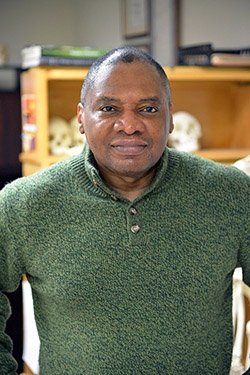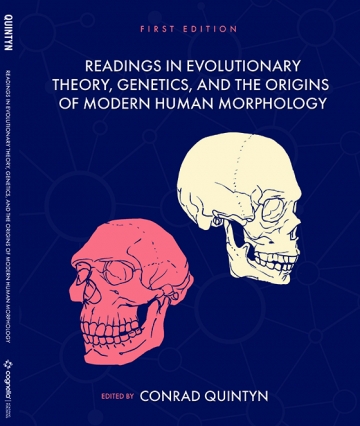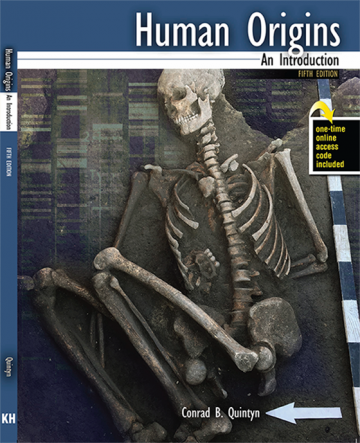Conrad Quintyn, Ph.D.

- Title(s)
- Associate Professor
- Department
- Education
Ph.D. University of Michigan
M.A. University of Michigan
B. A. Baylor University
- Contact Information
-
- 570-389-5379
- Send an Email
-
146B Centennial Hall
Why Anthropology?
"I was always interested in history, peoples, and culture. Then I took my first course in Anthropology as an undergrad at Baylor University. This was a general Introduction to Anthropology course covering human cultural and biological evolution.
I really enjoyed the biological evolution portion of this course. I enjoy thinking about questions, such as are humans evolving? Have humans stopped evolving? Are our brains getting bigger? Or, will the Homo sapiens suffer the same fate as the dinosaurs?
I am fascinated by human origins, especially the competing hypotheses Out of Africa and Multiregional Evolution. Specifically, did a modern human species evolve solely in Africa and moved out replacing all existing hominid species in the Old World without interbreeding? Or did modern humans evolve in different regions of the Old World maintaining gene flow between populations. These hypotheses are fascinating but difficult to test.
In conclusion, the holistic nature of Anthropology allows one to discuss other, more practical issues, such as "race" and intelligence, "race" and forensic anthropology, the evolution of human diseases, evolution of human behavior, etc. These are issues which are very important in modern society."
Veteran: U.S. Navy (Honorably Discharged)
Member of the American Academy of Forensic Sciences ID#128188
Member of the American Association of Physical Anthropologists
ID#: 066569
Interests
Forensic Anthropology, forensic Anthropology and "Race," Worldwide postcranial variation, Evolution of Human Diseases, and Evolutionary Biology.
Scholarship
2022 — Questionable Affiliation of Five Curated Human Crania: Using MicroScribe 3D Digitizer and FORDISC 3.1 Computer Program to Estimate Ancestry and Sex. Journal of Forensic Research 13:9: 516-526. DOI: 10.37421/2157-7145.2022.13.516
2019 — Quintyn, C.B. Three High Profile Genus Homo Discoveries in the Early 21st Century and the Continuing Complexities of Species Designation: A Review—Parts 1 and 2. Sociology and Anthropology 7, 276 – 287.
2018 — Quintyn, C.B. Human Origins: An Introduction. 5th Edition. Dubuque: Kendall Hunt.
A2017 — Seguchi N, Quintyn CB, Yonemoto S, Takamuku H. An assessment of postcranial indices, ratios, and body mass versus ecogeographical variables of prehistoric Jomon, Yayoi agriculturalists, and Kumejima Islanders of Japan. Am J Hum Biol. 2017;00:e23015.
2016 — Quintyn, Ph.D., Religion and Science: The Reality of Compatibility and Illusion of Conflict. Sociology and Anthropology, 4, 249 - 256. doi: 10.13189/sa.2016.040407.
2015 — Quintyn, Ph.D., and N. Seguchi of the Department of Environmental Changes, Kyushu University, Japan had a paper, "Variation in body and limb proportions between Early and Archaic Americans and the prehistoric Jomon of Japan," accepted and presented at the 84th Annual Meeting of the American Association of Physical Anthropologists in St Louis, MO, March 2015.
J2014 — Quintyn, C.B. 2014. Human Origins: An Introduction 4th edition. Dubuque, IA: Kendall/Hunt Publishing.
2013 — Quintyn, Ph.D., was awarded a Commissioner’s Area Command Significant Achievement Award by the Pennsylvania State Police.
2013 — Quintyn, Ph.D., and co-authors N. Seguchi and H. Takamuku of the Department of Environmental Changes, Kyushu University, Japan had a paper, "A Study of Postcranial Indices, Ratios, and Body Mass versus Eco-geographical Variables in An Assessment of Phenotypical Adaptations to Climatic Conditions," accepted and presented at the 82nd Annual Meeting of the American Association of Physical Anthropologists in Knoxville, Tenn., April 2013.
Relevant Publications
2023 — Quintyn, C.B. Physical Anthropology and Race: A Reckoning for the Newly Renamed “Biological” Anthropology in 2020 and Beyond. Journal of Sociology and Anthropology 7(1): 1-10.
2023 — Quintyn, C.B. Using a Killer’s Statements as Critical Evidence to Support a Charge of Third-Degree Murder (as Opposed to Self-Defense) When Physical Evidence is Inconclusive: A Case Report. Journal of Forensic, Legal & Investigative Sciences 9:076.
2023 — Quintyn, C.B. Estimating Ancestry from a Recovered Cranium Using the FORDISC 3.1 Computer Program: A Possible Case of Admixture — Case Report. Journal of Forensic, Legal & Investigative Sciences 9: 073.
2023 — Quintyn, C.B. Assessing Columbia County’s Pennsylvania State Police Knowledge in Distinguishing Human vs. Nonhuman Bones: A Radical Case for Adding Basic Mammal Osteology to State Police Academy’s Curriculum in Crime Scene Investigation. Journal of Forensic Research 14:537.
2022 — Quintyn, C.B. Biotechnology: Scientific Advancement versus Public Safety. First Edition. World Scientific Publishing.
2021 — Quintyn, C.B. Genetic Engineering in the Twenty-First Century: Genetically modified Organisms. Global Journal of Ecology 6: 073-075. DOI: https://dx.doi.org/10.17352/gje.0000147.

2021 — Quintyn, C.B. “How Do We Define and Identify Species in the Fossil Record.” In C. Quintyn (Ed.), Evolutionary Theory, Genetics, and the Origins of Modern Morphology. Preliminary Edition. San Diego: Cognella Academic Publishing, pp. 121-123. researchgate.net/publication/342130917.
2020 — Seguchi, N., Quintyn, C.B. “A Craniofacial and Postcranial Survey of North and South American Inhabitants from the Perspective of Possible Old World Ancestors.” In N. Matsumoto, S. Sugiyama & C. Garcia-Des Lauriers (Eds.), Landscapes, Monuments, Arts, and Rituals Out of Eurasia in Bio-Cultural Perspectives. Research Institute For the Dynamics of Civilization, Okayama University, Japan. Proceedings of an International Conference in Mexico, February 27-28, 2020, pp. 141-154.
2019 — Quintyn, C.B. Three High Profile Genus Homo Discoveries in the Early 21st Century and the Continuing Complexities of Species Designation: A Review—Parts I and 2.
2017— Seguchi N, Quintyn CB, Yonemoto S, Takamuku H. An assessment of postcranial indices, ratios, and body mass versus ecogeographical variables of prehistoric Jomon, Yayoi agriculturalists, and Kumejima Islanders of Japan. Am J Hum Biol. 2017;00:e23015

2016—Quintyn, C.B. Human Origins: An Introduction. 4th edition. Revised Printing. Dubuque, IA: Kendall/Hunt
2016 — Quintyn (2016). Religion and Science: The Reality of Compatibility and Illusion of Conflict. Sociology and Anthropology, 4 , 249 - 256. doi: 10.13189/sa.2016.040407
2014 — Quintyn, C.B. 2014. Human Origins: An Introduction 4th edition. Dubuque, IA: Kendall/Hunt Publishing
2012 — Quintyn, C. B. 2012. Human Origins: An Introduction. 3rd Edition. Dubuque, IA: Kendall/Hunt Publishing
2011 — Quintyn, C. B. 2011. Human Origins: An Introduction. 2nd Edition. Dubuque, IA: Kendall/Hunt Publishing
2010 — Quintyn, C.B. 2010. The Existence or Non-existence of Race? Forensic Anthropology, Population Admixture, and the Future of Racial Classification in the U.S. New York: Teneo Press
2010 — Quintyn, C.B. 2010. Human Origins: An Introduction. Dubuque, IA: Kendall/Hunt Publishing
2009 — Quintyn, C. The naming of new species in hominin evolution: A radical proposal – A temporary cessation in assigning new names. Journal of Comparative Human Biology 60(4): 307-341
2009 — Quintyn, C. and Wagner, S. Dismantling a national icon: Genetic testing and the tomb of the unknowns. American Anthropological Association Newsletter 50(5): 7-9 (May)
2007 — Dauria, S. and Quintyn, C. Anthropologists Confront the CSI Effect. American Anthropological Association Newsletter 48(8): 21 (November)
2006 — The Morphometric Affinities of the Qafzeh and Skhul Hominans: Method and Theory. Indiana: AuthorHouse
2006 — C.L. Brace, Noriko Seguchi, Conrad B. Quintyn, Sherry C. Fox, A. Russell Nelson, Sortis K. Manolis, and Pan Qifeng. The questionable contribution of the Neolithic and the Bronze Age to European craniofacial form. Proceedings of National Academy of Sciences , 103(1):242-247
Other Publications
2007 — The morphometric affinities of the Qafzeh and Skhul hominans: Method and theory. Bloomsbury Review 27(1):4
2006 — Forensic Anthropology. Pennsylvania Homicide Investigators Newsletter. December, pp. 5-6
2003 — The Father of Man: Meeting the True Adam. Merrimack: Write to Print Press
Technical Reports
(Pennsylvania State Police & Joint POW/MIA Accounting Command)
2018 — Analysis of Human Bone Fragments Recovered in Burn Pit on Property, Weatherly, Pennsylvania. Pennsylvania State Police Case #: PA 2018-209148
2018 — Consultation on Excavation of Potential Clandestine Burial at Dobson Cemetery, Shickshinny, Luzerne County
2012 — Quintyn, C.B. Forensic Anthropology Report of Bones Recovered from a Wooded Area
of Newport Township, Monroe County, Pennsylvania, November 2012. Pennsylvania State Case #P04-0744558
2010 — Quintyn, C.B. Forensic Anthropology Report of Bones Recovered from the Kelly Residence, Rainbow Lake Drive, Pocono Township, Monroe County, Pennsylvania, February 2010. Pennsylvania State Case #N04-0801632
2008 — Quintyn, C.B. Miscellaneous Animal Bone Material Recovered from Carbon County, October 2008. Pennsylvania State Police Case #N04-0905416.
2008 — Quintyn, C.B. Forensic Anthropological Report of Mutilated Skeletal Remains Recovered from a Wooded Area of Price Township, Pennsylvania, April 2008. Pennsylvania State Police Case #N06-0616191
2008 — Quintyn, C.B. Wound Analysis of Mutilated Remains Recovered Along Interstate 80 and Near the Mount Pocono Exit of Interstate 380, Northeastern, Pennsylvania, January 2008. Pennsylvania State Police Case #N06-0909468 (Addendum: Tool Type Analysis)
2008 — Quintyn, C.B. Wound Analysis of Mutilated Remains Recovered Along Interstate 80 and Near the Mount Pocono Exit of Interstate 380, Northeastern, Pennsylvania, January 2008. Pennsylvania State Police Case #N06-0909468
2007 — Exhumation and Reanalysis of Mutilated Human Remains from a 1976 Unsolved Murder (“Beth Doe”), Carbon County, Pennsylvania: Modified Forensic Anthropological Analysis, October 2007. Pennsylvania State Police Case #N03-027244
2002 — Quintyn, C.B. Forensic Anthropology Report CILHI 2001-144. Unpublished
2002 — Quintyn, C.B. and Buck, S. Material Evidence Report CILHI 1995-004-A-01 Through 08. Unpublished
2002 — Quintyn, C.B. Search and Recovery Report 2002/CIL/014, Aircraft Crash, OV-1A
Mohawk, Associated with REFNO 1751, Salavan Province, Samouay District, Lao People’s Democratic Republic, 7 February through 8 March. Unpublished
2001 — Quintyn, C.B. Search and Recovery Report 2001/CIL/062, a P-38G5LO Site Associated with Case PNG 111, Sigut Village, Clifton Plantation, East New Britain Province, Papua New Guinea, 16 July through August 2001. Unpublished
2001 — Quintyn, C.B. Search and Recovery Report 2001/CIL/086, an O2A Aircraft Crash Site Associated with REFNO 1726, Xepon District, Savannakhet Province, Lao People’s Democratic Republic, 7 November to 3rd December. Unpublished
2001 — Quintyn, C.B. Forensic Anthropology Report CILHI 1997-025-I-01. Unpublished
Abstracts
2023 — Estimating Ancestry from a Recovered Cranium Using the FORDISC 3.1 Computer Program: A Possible Case of Admixture. The Northeastern Academy of Criminal Justice Sciences Annual Conference, Williamsport, Pennsylvania May 31 to June 2.
2023 — Dauria, Susan and Conrad Quintyn. Revisiting the CSI Effect: college student perceptions of forensic. The Northeastern Academy of Criminal Justice Sciences Annual Conference, Williamsport, Pennsylvania May 31 to June 2.
2015 — Variation in body and limb proportions between Early and Archaic Americans and the prehistoric Jomon of Japan (co-authored). The 84th Annual Meeting, American Association of Physical Anthropologists, St. Louis, Missouri
2014 — An assessment of phenotypic adaptation of the Jomon hunters-gatherers and the Yayoi agriculturalists of Japan: A study of postcranial indices, ratios, and body mass versus eco-geographical variables (co-authored). The 83rd Annual Meeting, American Association of Physical Anthropologists, Calgary, Alberta Canada
2013 — A study of postcranial indices, ratios, and body mass versus eco-geographical variables in an assessment of phenotypic adaptation to climatic conditions (co-authored). The 82nd Annual Meeting, American Association of Physical Anthropologists, Knoxville, TN
2008 — Biological answers to social questions: Forensic anthropology, admixture, and the increasing difficulties in finding “race.” American Anthropological Association 107th Annual Meeting, San Franciso, California, November 19 to November 23, p. 524-525 (Abstract)
2008 — Admixture and the growing list of racial categories: Clarity or confusion for law Enforcement (and the public). Proceedings of the American Academy of Forensic Sciences 60th Anniversary Scientific Meetings 14, p.347 (Abstract)
2007 — The species problem: Revisiting the idea of a temporary cessation in the naming of new species in hominin evolution. American Journal of Physical Anthropology, Supplement 42, 194 (Abstract)
2006 — One step away from angels: The uphill battle in reversing 20 generations of American creationist thinking. American Anthropological Association 105th Annual Meeting, San Jose, California, November 14 to November 19. p.430 (Abstract)
2006 — Biological anthropology, evolution, and science: a new perspective on why the theory of evolution is not resonating with the general public. American Journal of Physical Anthropology, Supplement 42, 150 (Abstract)
2005 — Qafzeh and Skhul: Descendants of anatomically modern humans or archaic Homo sapiens. American Anthropological Association 104 Annual Meeting, Washington, D.C., November 30 to December 4, p.461 (Abstract)
2002 — Human evolution: a Neanderthal skeleton in a sapiens closet. American Journal of Physical Anthropology. Supplement 34, 47 (Abstract)
2000 — Mosaic evolution and modern human origins: the picture from the Levant. American Journal of Physical Anthropology. Supplement 30, 256 (Abstract)
1998 — Using canonical variates and generalized distances on the postcrania of Qafzeh, Cro-Magnon, Predmosti, Taforalt, Neolithic French, Natufians, and recent moderns to assess population affinities. American Journal of Physical Anthropology. Supplement 28, 227 (Abstract)
